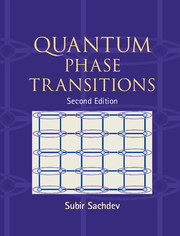Book contents
- Frontmatter
- Contents
- From the Preface to the first edition
- Preface to the second edition
- Part I Introduction
- Part II A first course
- Part III Nonzero temperatures
- Part IV Other models
- 16 Dilute Fermi and Bose gases
- 17 Phase transitions of Dirac fermions
- 18 Fermi liquids, and their phase transitions
- 19 Heisenberg spins: ferromagnets and antiferromagnets
- 20 Spin chains: bosonization
- 21 Magnetic ordering transitions of disordered systems
- 22 Quantum spin glasses
- References
- Index
21 - Magnetic ordering transitions of disordered systems
from Part IV - Other models
Published online by Cambridge University Press: 16 May 2011
- Frontmatter
- Contents
- From the Preface to the first edition
- Preface to the second edition
- Part I Introduction
- Part II A first course
- Part III Nonzero temperatures
- Part IV Other models
- 16 Dilute Fermi and Bose gases
- 17 Phase transitions of Dirac fermions
- 18 Fermi liquids, and their phase transitions
- 19 Heisenberg spins: ferromagnets and antiferromagnets
- 20 Spin chains: bosonization
- 21 Magnetic ordering transitions of disordered systems
- 22 Quantum spin glasses
- References
- Index
Summary
This chapter has been co-authored with T. Senthil, and adapted from the Ph.D. thesis of T. Senthil, submitted to Yale University (1997, unpublished).
The last two chapters of this book move beyond the study of regular Hamiltonians that have the full translational symmetry of an underlying crystalline lattice and consider the physically important case of disordered systems described by Hamiltonians with couplings that vary from point to point in space. By the standards of the regular systems we have already discussed, the quantum phase transitions of disordered systems are very poorly understood, and only a few well-established results are available. A large amount of theoretical effort has been expended toward unraveling the complicated phenomena that occur, and they remain active topics of current research. The aims of our discussion here are therefore rather limited: we highlight some important features that are qualitatively different from those of nondisordered systems, make general remarks about insights that can be drawn from our understanding of the finite-T crossovers in Part II, and discuss the properties of some simple solvable models.
In keeping with the general strategy of this book, we introduce some basic concepts by studying the effects of disorder on the magnetic ordering transitions of quantum Ising/rotor models studied in Part II; we also make some remarks in Section 21.4 on the effects of disorder on the ordering transitions of Fermi liquids considered in Chapter 18. Models with much stronger disorder and frustrating interactions that have new phases not found in ordered systems are considered in Chapter 22.
- Type
- Chapter
- Information
- Quantum Phase Transitions , pp. 437 - 462Publisher: Cambridge University PressPrint publication year: 2011



